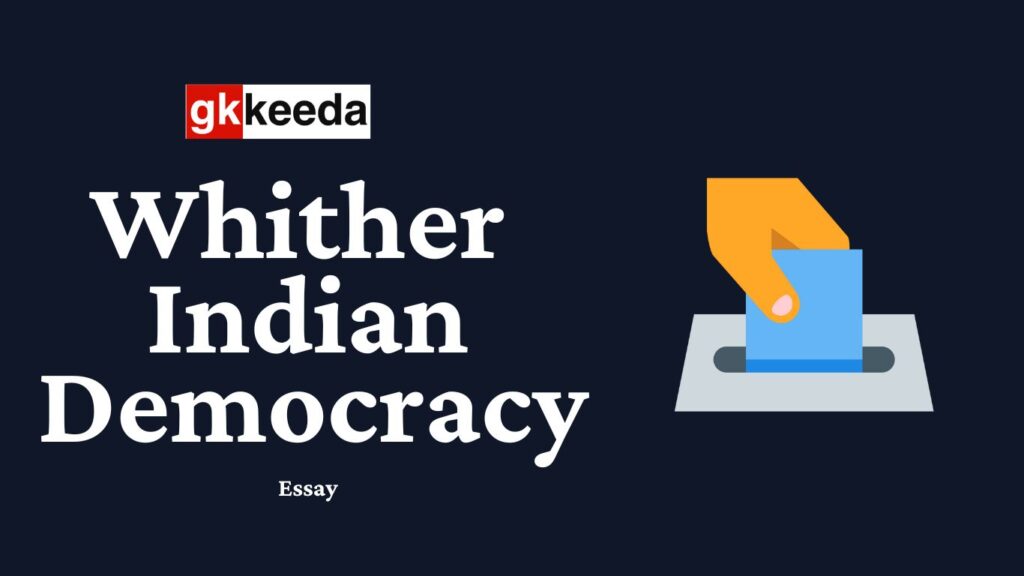Whither Indian Democracy
UPSC CSE Essays: Whither Indian Democracy

Introduction:
- Introduce democracy as a miracle in India or report on India’s democracy as low performing or Winston Churchill’s views on democracy vs how Nehru was sure about India’s suitability for democracy.
India and democracy – overview of the past
- Ancient: oldest deliberative democracy – Buddist councils
- Medieval: oldest participative democracy (Chola inscriptions);
- Modern: liberal educated Indians demanded it, Gandhi preached localized democracy, British introduced it under pressure from nationalists.
Dignity is at the core of the Indian way of life, Manusmriti and Buddist Tripitaka talk about the social contract as the origin of the State showing our democratic roots.
Modern Democraric India
- Indian Preamble reads India is a republican democracy.
- UAF, having voting rights to women before West.
- Social democracy: equality of all religions and castes.
- Economic democracy envisioned by DPSC: zero hunger, education, and health for all.
Bringing democracy to doorsteps is my aim – Nehru. Thus restarted our tryst with destiny.
72 years of Indian democracy:
- Grand story:
- It’s called a miracle democracy for its unmatched stability. While other nations balkanized or became military states, India remains a thriving democracy with the people as sovereign.
- Dalits and Muslims as presidents, women CMs in the four directions, number of women MPs is only on the rise. Minorities such as Bollywood superstars and minority ethnic clans integrated with India.
- The fastest poverty reduction happened in this democracy in human history ever – World Bank.
Flip side:
- Political ideals: Perios of interruptions – dark days of emergency, shaking of foundations during coalition period, rising criminalization of politics, not much encouraging women share in power, poor voter turnout in cities, highly delayed and shockingly expensive justice delivery.
- Social ideas: Communal violence unabated (Muzaffarnagar, Dadri, Ayodhya case), discrimination of Dalits unflinching (Rohit Vemula, 52% households agree they do untouchability, Bhima Koregaon violence), rape of women on a steep rise, transgender stigmatization, etc.
- Economic ideals: Oxfam’s shocking findings of inequality, 2nd largest poors, which might have shot up during the pandemic, regional inequality, farmer and rural distress,
- Governance: worrisome ranks in Corruption Perception Index, diluted RTI and murdered RTI activists, crippled Lokpal, etc.
India is a soft state – Gunnar Myrdal. It can’t achieve what it wants.
India is a land of contrast – poverty with prosperity, regular elections yet regular corruption.
Heading towards what?
- The bright spots:
- Political: women’s activism and participation are more likely. Strengthening of laws for Dalits, etc.
- Rising democratization of environmental issues e.g. Sterlite protest will continue and the government will be held more accountable.
- Poverty may reduce which will be facilitated by optimistically predicted economic recovery and increasing chit being given to welfare mechanisms.
- More powers for the electoral bodies with inducement from the judiciary, rising use of NOTA, and an increasing role for Lokpal can be expected.
- A more stable one-party system or a wisely built coalition is most likely,
- Parliament will be stronger vis a vis executive under any probable coalition coming in the future, if one party continues, this won’t happen.
- Undesirable destinies
- In the near term:
- No reversal of criminalization of politics
- No reduction in corruption
- Inequality will shoot up, especially with the advent of 4th industrial revolution
- No light at the tunnel end for faster and more equitable justice delivery
- New rights issues like data security and universal health coverage won’t be perfect in a short term.
- In the near term:
How do we trouble shoot?
- The most sought electoral reforms (more powerful to ECI, more independence, permanent ban on convicted ones), judicial reforms (more arbitration, more number of judges, hi-tech infra),
- Reforming anti-defection law and separating Speaker from party influence to restore the temple of democracy
- Promoting inclusive growth: outcome-based education, preventive healthcare and universal insurance, employable skills, micronutrient-laden diet,
- Empowering tribes minorities and Dalits and women with entrepreneurship, faster courts effective rehabilitation, and a compensation system.
- Cosmopolitan arm of our democracy: humanism is the keystone of democracy, real democracy prefers dignity to nationality,
- Contribution to world peace and prosperity with inclusivity should rise e.g. UN Development Partnership Fund
- Mediating and bringing justice for refugees and victims of crimes against humanity like Rohingyas, Ahmadiyas
- End world terrorism and clash of civilization
- Promote Vasudeva kutumbakam as the ultimate end of Indian democracy
Is crisis of Indian democracy – deep rooted value crisis? Yes.
- For democracy to head to the right destiny we need:
- Courageous and patriotic citizens
- Tolerant and honest politicians
- Bureautic with service spirit and democratic attitude
- Media with integrity, NGOs with public spirit, pressure groups with objectivity
Conclusion:
Conclude by summarising the easy. Democracy is nothing new for India, 72 years of modern independent democracy was indeed a miracle yet that gives no excuse for the mixed outcomes, future is both black and white, a overhaul reform along with value regeneration is needed to end our tryst at right destiny, a democracy not just for Indian welling but human civilization to rise and thrive.



No Comment! Be the first one.